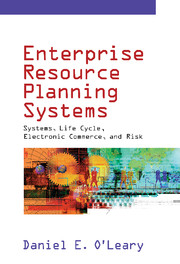Book contents
- Frontmatter
- Contents
- Acknowledgments
- PART ONE INTRODUCTION AND BACKGROUND
- PART TWO ERP SYSTEMS
- PART THREE ERP LIFE CYCLE
- 7 Deciding to Go ERP
- 8 Choosing an ERP System
- 9 Designing ERP Systems: Should Business Processes or ERP Software Be Changed?
- 10 Designing ERP Systems: Choosing Standard Models, Artifacts, and Processes
- 11 Implementing ERP Systems: Big Bang versus Phased
- 12 After Going Live
- 13 Training
- PART FOUR ELECTRONIC COMMERCE AND RISK
- Index
13 - Training
from PART THREE - ERP LIFE CYCLE
Published online by Cambridge University Press: 05 June 2012
- Frontmatter
- Contents
- Acknowledgments
- PART ONE INTRODUCTION AND BACKGROUND
- PART TWO ERP SYSTEMS
- PART THREE ERP LIFE CYCLE
- 7 Deciding to Go ERP
- 8 Choosing an ERP System
- 9 Designing ERP Systems: Should Business Processes or ERP Software Be Changed?
- 10 Designing ERP Systems: Choosing Standard Models, Artifacts, and Processes
- 11 Implementing ERP Systems: Big Bang versus Phased
- 12 After Going Live
- 13 Training
- PART FOUR ELECTRONIC COMMERCE AND RISK
- Index
Summary
One of the most important issues in the ERP engagement is training. According to the CIO of Brother Industries, “[t]he easiest mistake to make is underestimating the time and cost of training end users” (Fortune 1998, p. 151). An implementation will be a failure if the software runs perfectly, but employees don't know how to use it. Despite the importance associated with the need for ERP training, a Benchmarking Partners survey of 150 sites found that 43% indicated that the amount of training was the biggest surprise encountered (Stedman 1998b).
However, training encompasses more than just users; the training concerns of implementors must also be addressed. Moreover, training is not simply one step in the life cycle just before or just after implementation. Rather, training is embedded in each part of the life cycle. We therefore discuss training within its own chapter.
Frequently Asked Questions about User Training
How should user training be timed?
How much training should users get?
How do you make up time lost on training?
When should you train?
How can employees be encouraged to train?
How much should training cost?
What is in the training materials: information technology or rather business information?
Should you use script-based or general support materials?
How should training be structured?
Can faster training be developed?
- Type
- Chapter
- Information
- Enterprise Resource Planning SystemsSystems, Life Cycle, Electronic Commerce, and Risk, pp. 186 - 192Publisher: Cambridge University PressPrint publication year: 2000

